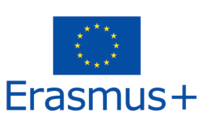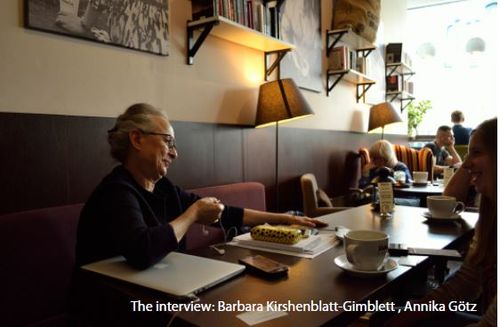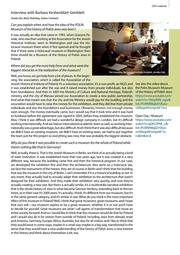Interview with Barbara Kirshenblatt-Gimblett
|
Interview with Barbara Kirshenblatt-Gimblett
„I could not make it to Opatów for the Erasmus project on the day devoted to my father, his memories, and his paintings, so Erasmus students came to me in Warsaw – those from a German high school. One student is devoting her project to my father and wanted to interview me, so the group arrived to WakeCup Cafe, where I am deliciously ensconsed for the day writing. They are in Warsaw on their way back to their small town in Germany. They are part of a pan-European group of high school students studying traces of Jewish life in Europe. Sitting with these young German high school students, who wanted to interview me about POLIN Museum and about my father and his memories, brought me to tears.“
It was actually an idea that came in 1993, when Graźyna Pawlak, who was then working at the Association for the Jewish Historical Institute, went to Washington and saw the Holocaust museum there when it first opened and he thought that if there were a Holocaust museum in Washington then there should be a Museum of the History of Polish Jews in Poland. Where did you get the most help from and what were the biggest obstacles in the realization of the museum? Well, you know, we got help from a lot of places. In the beginning, the association, which is called the Association of the Jewish Historical Institute of Poland, it’s a voluntary association, it’s a non-profit, an NGO, and it was established just after the war and it raised money from private individuals, but also from foundations. And then in 2005 the Ministry of Culture and National Heritage, Poland’s ministry, and the city of Warsaw joined our Association to create a new public partnership. And what that meant was that the city and the Ministry would pay for the building and the association would have to raise the money for the exhibition, and they did that from private individuals and also the foundations and businesses. Obstacles, hmmm, not enough money soon enough. The money eventually came, but I would say that it took time and it was hard to fundraise before the agreement was signed in 2005, before they established the museum. Also, I think it was difficult, we had a wonderful design company in London, but it’s difficult working internationally. And we had an international academic team as well, so working internationally was a great advantage, but also difficult. And I think that it was also difficult because we didn’t have an existing museum, we didn’t have an existing team, we had to put together the team just for this project so everything was new, that was probably the biggest obstacle.
Nachgestellte Szenerie im jüdischen Museum Warschau
Well, actually, there is. That is the Jewish Museum in Berlin, we think of as actually being a kind of sister institution. It was established more than two years ago, but it was created in a very different way, because the building came first and then the historical program. In our case, we developed the exhibition first and then the architecture. Also we’re on a holocaust site, we face the monument of the heroes, they are of course in Berlin and I think that the building that was the museum in the city of Berlin, I can’t remember if it is a historical building or not. In any event, they actually had to actually adapt their exhibition to the architecture that wasn’t designed for their exhibition. And they made their exhibition very quickly, and now they’re actually creating a new one. But theirs is actually similar, it’s a multimedia narrative exhibition that is the whole history of Jews in what became German territory, extending back to Roman times, so in their case it’s 2000 years. It’s actually, I think, it’s different from our museum, but it’s in the same general category, and it’s similar in size. What do you think is the most important effect of this museum in Poland? Well, I think that great museums, great museums, and I hope that ours will—our museum aspires to be a great museum, whether it is or not you’ll have to decide for yourself. Great museums are what I call agents of transformation that move an entire society forward. And so I would like to think that this museum would do that for Poland and I would also do it for visitors from outside of Poland. Including Jews from abroad, Israel and America, Germany, Europe, Africa, Australia, but also for all visitors and I like to think that they would leave in some ways, maybe in a small way maybe in a big way, transformed in the sense that they would have a new understanding of the history of Polish Jews, a new interest in this history and think about themselves a bit, too.
Well I think it’s an amazing project actually. And I’m glad you’re here.
Well, when I first came to Poland in 1981 I wanted my father to come with me and he didn’t want to come. He hadn’t been back since—he had never been back to Poland since he left in 1934. So I went by myself, and I came home and I showed him photographs and talked to him and about seven years later he said he’d like to go. So I took him. And on that visit he was really anxious, and he didn’t want to spend much time at the hotel. And then he started to paint in 1990 and I took him and my mother with me in 1995 when I was teaching in Krakow. And they stayed with me in Krakow, they stayed for about six weeks and during that time I took them to Opatow, and this time he had his paintings, I took photographs of his paintings, and he had them with him. And he was very, very, how can I say, eager, to meet people in the town, show them the paintings and ask them if anybody remembered anything. And so, one young man took an interest and invited us to his home and invited his grandmother. And after we left, he struck up a friendship with my father and they stayed in touch over the years. And he followed my father’s career, you know, my father was 73 when he started his career. And he knew about the exhibition, he knew about the book, he knew about the film, and he convinced the county chief that they should make an exhibition on my father’s work in Opatow. And so things developed from there.
I would say it was primarily economic. His family left for mainly economic reasons when he was a young man, he said he left because he couldn’t see a future for himself. And that is why he left.
Oh I think really for him it was a huge opportunity. When he first came to Canada, he tells a nice story. He says, I came in February and it was actually quite cold, and he heard a fire engine, and in Opatow when he heard a fire engine he could run after it and get to the fire. But in Toronto, it’s a big city, and he didn’t realize how big it was, and he started running after the fire engine and he realized he’d never get to the fire. So he wasn’t dressed for the cold either. So he realized this is a big city. I think he learned English by watching movies, because he was 17 and they put him into a, I don’t know, a grade seven class or something like this to learn English. He was a big, young man, smoking cigarettes, and this was hopeless, but he learned English, and he’s very proud he’s so good at English.
That’s a good question. I think that it was my interest and that he got older. You know when people get older, things change.
Well you know, they cover, well when he began, he was a reluctant painter, he didn’t want to start painting. He didn’t have confidence that he could. So my mother convinced him to start. Well, actually, I tried, my husband tried, my mother tried for about ten years and then she finally, she came up one day and she said to him, “I signed you up for art classes. And they don’t take refunds.” So he had to go to the art classes, which didn’t last very long, because he hated it. I said to him, “You know, forget the art classes, just paint what you can remember.” And my mother said to him, “Why don’t you paint the kitchen, paint it for Barbara, she’ll use it in her work” because she knew that I loved his kitchen. And I’m interested in food, kitchens, whatever. So he did. And he was very surprised, actually, at what he had done. And so he started in the kitchen and then did the rest of the house and then went to the courtyard and then he went outside the courtyard to the market and then he started to paint, you know, more and more. Mainly I think, he, I think it was from the interviews. Eventually, he would say, what am I going to paint? So I would talk with him and we would make a list of subjects and then he would think for a while and he would call me up and say, “Where’s the list?” and I’d have to go down the list and say, “Ok, you did Purim, you did Passover, what about the rest of the holidays?” Or “You did birth, but what about Bat Mitzvah, what about this, what about that?” So it was, you know, I knew from the interviews that I’d done with him that he has a very visual memory, so I already knew that some things were very, very visual for him so I’d say, “Remember you told me about this, you told me about that.” So it was kind of a collaboration to really, I would say, to spark his memory, and encourage him because he’s really visual in his thinking and his memory is really visual, which I think is the key to why he can remember so well.
Well, it was really amazing, because the church was very supportive, and the county chief, and they put big posters, which announced the exhibition, and they put posters up around the town. And the—on one visit, it was like an illustrated lecture and the museum in the county seat, they had a building and they called it a museum, they filled the whole room, and everybody was there. And they gave my father a standing ovation. The exhibition itself, they had a beautiful ceremony, a ribbon cutting, and everyone came, and he was so warmly received it was really incredible.
I would say, that they would cover a lost world. A world that is in his memory and he had a very special way of remembering, so it’s his experience. I think what’s really valuable about his memory is that even though we lost many, many of our family in the Holocaust, he himself, experienced trauma as well. What that means is that his memory of childhood are filtered to that trauma, because that trauma, he has some friends that survived the Holocaust and their memories, they almost can’t remember life before the war, because their memory of the war is so vivid, so painful, that it overwhelms all their old memories. And in his case, in the sense, he has an extraordinary memory anyway, but I think that it’s really, he was old enough when he left to have lived there long enough, but he left before the Holocaust and so it’s a very unusual situation.
I think it was a gift to the world, and that it was something very important to him, but also to me, that what he remembered was so important, and the way he remembered was so important that we wanted to share it because we felt that there was nothing like it ever. Nobody had ever done anything like this, either you had words, bibliographies, or you had paintings, but you never had this kind of combination. And so it was very unusual, very special, very complete. It was very comprehensive. How do you see the contribution of his pictures to the representation of Jewish life and culture? Well, first of all, it’s a visual account from one person’s experience and it’s also I would say uncensored and unvarnished. Meaning that it’s all aspects of life, the good, the bad, the ugly, the obscene, the ----. Also there’s wit, there’s humor, there’s irony, and I would say that there’s less fantasy than in other accounts, and there’s more irony, more humor, I would say, it’s a very individual vision. Great, thank you for the interview, it was fantastic. Thank you very much. After every single question. Let’s see, well, let me just say this, I am very deeply moved. (Das Interview wurde geführt von Annika Götz, Moritz Thelenberg, Andreas Scherbach)
|





